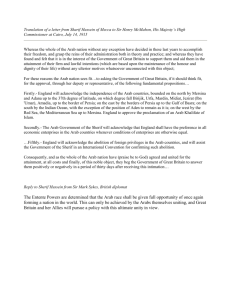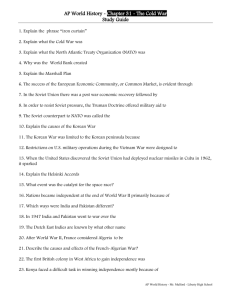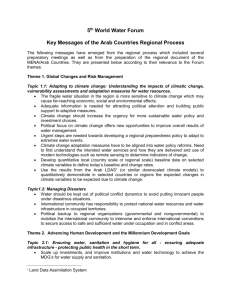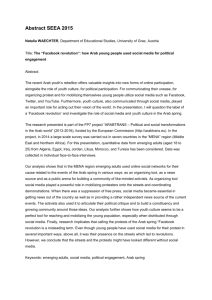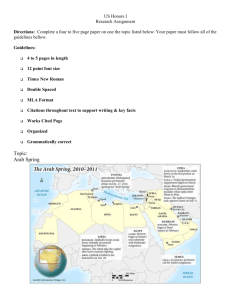Stage Setting - Orchestrating the Instruments of Power
advertisement
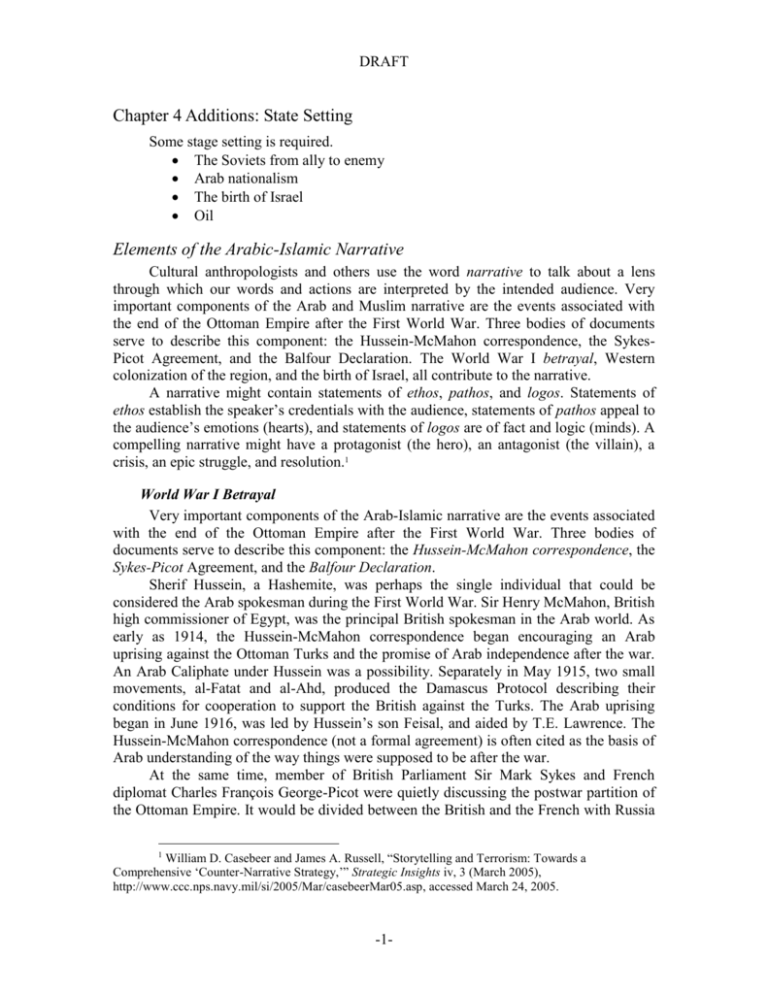
DRAFT Chapter 4 Additions: State Setting Some stage setting is required. The Soviets from ally to enemy Arab nationalism The birth of Israel Oil Elements of the Arabic-Islamic Narrative Cultural anthropologists and others use the word narrative to talk about a lens through which our words and actions are interpreted by the intended audience. Very important components of the Arab and Muslim narrative are the events associated with the end of the Ottoman Empire after the First World War. Three bodies of documents serve to describe this component: the Hussein-McMahon correspondence, the SykesPicot Agreement, and the Balfour Declaration. The World War I betrayal, Western colonization of the region, and the birth of Israel, all contribute to the narrative. A narrative might contain statements of ethos, pathos, and logos. Statements of ethos establish the speaker’s credentials with the audience, statements of pathos appeal to the audience’s emotions (hearts), and statements of logos are of fact and logic (minds). A compelling narrative might have a protagonist (the hero), an antagonist (the villain), a crisis, an epic struggle, and resolution.1 World War I Betrayal Very important components of the Arab-Islamic narrative are the events associated with the end of the Ottoman Empire after the First World War. Three bodies of documents serve to describe this component: the Hussein-McMahon correspondence, the Sykes-Picot Agreement, and the Balfour Declaration. Sherif Hussein, a Hashemite, was perhaps the single individual that could be considered the Arab spokesman during the First World War. Sir Henry McMahon, British high commissioner of Egypt, was the principal British spokesman in the Arab world. As early as 1914, the Hussein-McMahon correspondence began encouraging an Arab uprising against the Ottoman Turks and the promise of Arab independence after the war. An Arab Caliphate under Hussein was a possibility. Separately in May 1915, two small movements, al-Fatat and al-Ahd, produced the Damascus Protocol describing their conditions for cooperation to support the British against the Turks. The Arab uprising began in June 1916, was led by Hussein’s son Feisal, and aided by T.E. Lawrence. The Hussein-McMahon correspondence (not a formal agreement) is often cited as the basis of Arab understanding of the way things were supposed to be after the war. At the same time, member of British Parliament Sir Mark Sykes and French diplomat Charles François George-Picot were quietly discussing the postwar partition of the Ottoman Empire. It would be divided between the British and the French with Russia William D. Casebeer and James A. Russell, “Storytelling and Terrorism: Towards a Comprehensive ‘Counter-Narrative Strategy,’” Strategic Insights iv, 3 (March 2005), http://www.ccc.nps.navy.mil/si/2005/Mar/casebeerMar05.asp, accessed March 24, 2005. 1 -1- DRAFT having the dominant role in the north. The British and French would have direct control in some areas and indirect control in others. Semi-autonomous Arab states would be possible where indirect European control existed. The resulting secret document is the Sykes-Picot Agreement. The Balfour Declaration—a letter from British diplomat Arthur J. Balfour to the head of the British Zionist Organization Lord Rothschild in November 1917—indicated the British government’s positive view towards a Jewish homeland in Palestine. Palestine was at the time an undefined area. A condition of the new homeland would be that the rights of the non-Jewish community would not be prejudiced. The entirety is often evoked as “Sykes-Picot,” and has the connotation of “white man speaks with forked tongue.” It represents past betrayal and predicts future betrayal associated with the Western alliance including present-day Israel. Sykes-Picot is in more recent memory than good deeds done for Muslims by the United States in Kosovo and elsewhere. It remained in recent memory throughout relief operations in Indonesia, the country with the largest Muslim population. Self determination has been thwarted for the Arab nation. Direction of Arab history has been determined by the West. Everything the US says and does is interpreted through this lens. Pan Arabism is the term used to refer to the Arab nation’s desire for self determination. Salifism, Wahhabism, and Qutbism The terms Salifism, Wahhabism, and Qutbism are not universally accepted within Sunni Islam, and it appears that some shift in meaning has taken place after 9/11. Still, some characterization is necessary to have at least a rudimentary understanding of the “narrative.” It appears that Salafi is the more general term. The Salaf is the first three generations of Islam. Salafists, Wahhabists, and Qutbists accept the Qur’an (scripture), Hadith (traditions of the prophets), and Ijma’ (consensus) as the sources of Islamic law. All three are fundamentalist as defined by Western dictionaries to include adherence to a literal interpretation of scripture, the inerrancy of that scripture, and often intolerance for other views. Innovations and interpretations of Islamic law beyond the first three generations are rejected. Ibn-Taymiya (1263-1328) is perhaps the original godfather of radical Islam—a Salafist before the term existed. The capture of Baghdad and the overthrow of the Abbasid caliphate in 1258 by the invading Mongols was a catastrophic event for the believers and required an explanation. Taymiya was a disciple of the Hanbali School of jurisprudence, the most conservative of the four major schools of Sunni legal and religious thinking, which rejected innovations and called for a revival of early Islamic practices. He spoke against apostate leaders who cooperated with Mongols but saved his real venom for the Mongols. Today, when Abu Mussad Zarqawi compares the United States to Mongol invaders, he is evoking this old image. Ibn-Taymiya’s writings are a strong influence on Muhammed ibn Abd al Wahhab, Sayyid Qutb, Ayman al-Zawahiri, and Usama bin Laden. Wahhabism is the official religion of Saudi Arabia. In addition to the three classic sources of Islamic law, Wahhabist also rely on the writings of Muhammad ibn Abd alWahhab (1703-1792) who, among other things, argued for rejecting innovations and -2- DRAFT returning to Islam as understood by the Salaf. Wahhabism spread across the Saudi Peninsula in the 18th century and was strengthened by the establishment of the Saudi state in the 20th century. Saudi oil wealth funds Wahhabist schools throughout the Muslim world. The thinking of Sayyid Qutb (1906-1966) is firmly centered in 1960s Egypt and a fundamentalist backlash against dictatorship and secular socialism. He was also profoundly and negatively influenced by a visit to America (1948-1950). Qutb was a member of the radical Muslim Brotherhood. After attempting to assassinate Gamal Abdel Nasser, the Brotherhood was banned and many jailed, including Qutb, who was later executed by Nasser’s government. Saladin and bin Laden The figure of Saladin is an important component of the Islamic narrative, and his role is necessary to understand the lens through which American words and actions are interpreted. Saladin’s importance is summed up by James R. Reston Jr.2 Until this day, Saladin remains a preeminent hero of the Islamic world. It was he who united the Arabs, who defeated the Crusaders in epic battles, who recaptured Jerusalem, and who threw the European invaders out of Arab lands. In the seemingly endless struggle of modern-day Arabs to reassert the essentially Arab nature of Palestine, Saladin lives, vibrantly, as a symbol of hope and as the stuff of myth. In Damascus or Cairo, Amman or East Jerusalem, one can easily fall into lengthy conversations about Saladin, for these ancient memories are central to Arab sensibility and their ideology of liberation. According to some, bin Laden is increasingly seen as the modern Saladin.3 The Great Game The Great Game (1813-1907) was a strategic competition between Czarist Russia and Great Britain over Central Asia and the Indian Subcontinent. It was apparently more of a preoccupation of the British in defense of India, the Empire’s crown jewel. The contest was centered in Afghanistan but involved the larger region. [Add something about Partition.] [Add something about British invasions.] Iran’s Political Progression Persia is an ancient and sophisticated civilization dating back several thousand years. [Persian Empire when?] The Arabs successfully Islamized Persia between the 7th and 9th centuries, but never Arabized it. It became an independent state in 1501. Persia’s Constitutional Revolution took place between 1906 and 1911. Moagaferedin Shah, who had ascended to the throne in June 1896, was forced by revolutionaries to adopt a constitution and elect a parliament on 5 August 1906. It 2 Warriors of God: Richard the Lion Heart and Saladin in the Third Crusade (New York: Anchor Books, 2001), p. xiv. 3 Anonymous, Imperial Hubris: Why the West is Losing the War on Terror (Washington, D.C.: Brassey’s, 2004). -3- DRAFT replaced a weak, centralized, and corrupt government with a constitutional monarchy, both preserving the shah and establishing an elected parliament. The constitution, modeled on the Belgian constitution, provided for the rule of law, equality, individual rights, universal public education, and freedom of the press. Crown Prince Mohammad Ali Mirza, ascended 21 June 1907, broke the constitution. Iranian politics was divided internally by progressive constitutionalists and conservative monarchists. The British and Russians announced a pact on 7 September 1907. They backed the shah but geographically divided the country between them. By dividing the country, they unified the Iranian factions. Great Britain and Russia intervened. Russian Cossaks stormed the parliament 23 June 1908 initiating a civil war. Christian missionaries pressured U.S. politicians to respond with tough action, but Presidents Teddy Roosevelt and William Taft maintained a policy of neutrality. The revolution ended in 1911 and Iranian constitutionalists turned to the noninterventionist United States for assistance. Two Americans served as “Treasury Secretary.” Relations between Iran and the United States would continue on favorable terms for 35 years. Reza Khan ascended to the thrown in 1925. He initiated industrial expansion, railroad building, and an educational system. To prevent Iran’s railroads and oil from falling to the Axis Powers, Great Britain and the Soviet Union invaded Iran in 1941. The shah was ousted and replaced with his son, Mohammed Reza Pahlavi. Oil With WWI developing, in 1903, British Foreign Secretary Lord Landsdowne warned Russia and Germany that Britain would “regard the establishment of a naval base or of a fortified port in the Persian Gulf by any other power as a very grave menace to British interests, and we should certainly resist with all the means at our disposal.” To prevent Iran’s railroads and oil from falling to the Axis Powers, Great Britain and the Soviet Union invaded Iran in 1941. Petroleum was of critical importance to the industrial-age army of WWII. The United States was then the world’s leading oil producer and supplied most of the oil for Allied armies. U.S. resources were not infinite, and positive relations with Saudi Arabia became a strategic necessity. On 16 February 1943, FDR said, “the defense of Saudi Arabia is vital to the defense of the United States.” The first Arab-Israeli war (known as the War of Independence in Israel and the Catastrophe by Palestinians) took place in 1948 after Israel announced its statehood and was recognized by the United States and the Soviet Union. Egypt, Syria, Iraq, Lebanon, and Jordan attacked the new state on [14-15 May 1948]. A truce formally ended the war in 1949. The second Arab-Israeli war as initiated by the Israelis and the great powers against Egypt over the Suez. Some Western texts do not count this as one of the Arab-Israeli wars. The third Arab-Israeli war, the Six-Day War, began on 5 June 1967. Arab states announced an oil embargo on any state providing aid to the Israeli military. The embargo was hastily constructed and ineffective. It did, however, lead to a policy statement from the Oil Minister’s Conference in Baghdad from 9-18 June. The policy stated that oil would be denied to any country directly or indirectly committing aggression on Arab -4- DRAFT territory; commercial assets and nationals inside Arab territories would be subject to the laws of war. The Khartoum Resolution ended the embargo on 1 September 1967. The Resolution gave moderate Arab governments the political cover to resume oil exports over their more radical populations. The victims of the war (Jordan and Egypt) were to be provided annual financial aid. The oil embargo also led to formation of OAPEC to discuss how to use oil for political purposes. On 15 August 1971, Nixon unilaterally withdrew from the Bretton Woods Accord. Under Bretton Woods, the value of the U.S. dollar was pegged to the price of gold, and all other currencies were pegged to the dollar. The dollar would now float. The industrialized nations followed suit. The oil exporters decided to peg oil prices to gold rather than to the dollar. The Oil Shock of the middle 1970s soon followed after twenty years of price stability was replaced by volatile oil prices. The fourth Arab-Israeli war, the Yom Kippur War, was initiated on 6 October 1973 when Syria and Egypt attacked Israel. Initial Arab successes make Israel’s position tenuous. The USSR undertook a massive resupply of Syria. On 12 October 1973, the United States initiated Operation Nickel Glass, an overt strategic airlift of weapons and supplies to Israel. On 16 October, OPEC raised the price of oil by 70 percent. The next day, OAPEC placed an oil embargo on the United States and then on Europe and Japan. On the 19th, Nixon proposed $2.2 billion in military aid to Israel. The following day, Libya, Saudi Arabia, and other producers joined the embargo. The war ended on 26 October 1973 in Arab defeat. Secretary of State Henry Kissinger announced Project Independence to achieve independence from imported oil on 11 February 1974. The embargo ended (with the exception of Libya) on 17 March 1974. The price of oil had quadrupled from $3 to $12 per barrel. The United Kingdom and France had been unaffected by the embargo. They remained neutral, refused U.S. access to their airfields, and embargoed arms to both Israelis and Arabs. The Oil Crisis of 1979 and the Oil Glut of the 1980s. The Iranian Revolution caused a serious disruption of Iran’s oil sector. The sector performed erratically and at a significantly reduced level. The world market overreacted. The Iran-Iraq War devastated both countries’ oil output. Other exporters responded by increasing output. The resulting overproduction and reduced demand led to declining oil prices from 1980 to 1986. The so called Oil Glut of the 1980s was an exaggerated name. -5-

